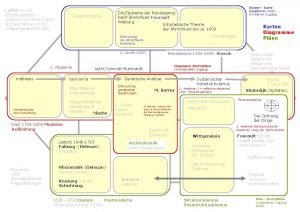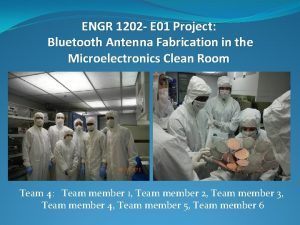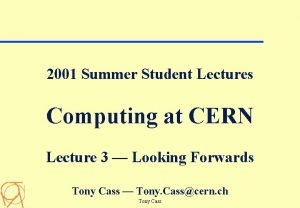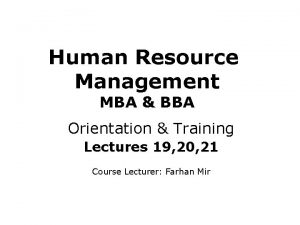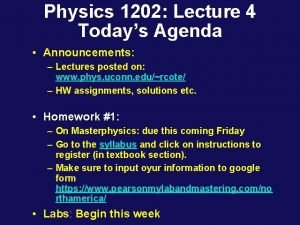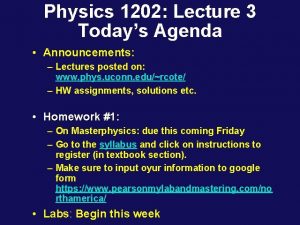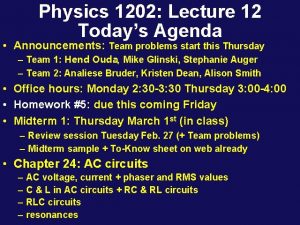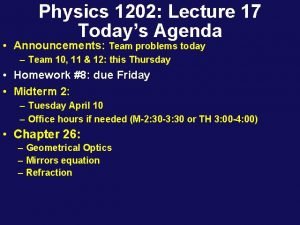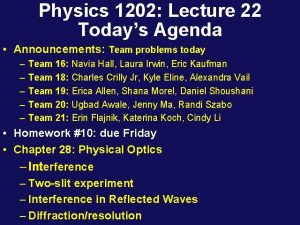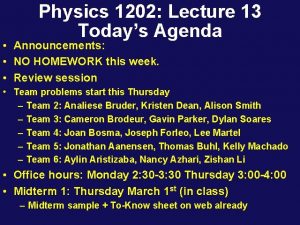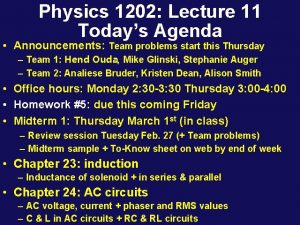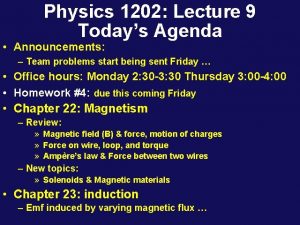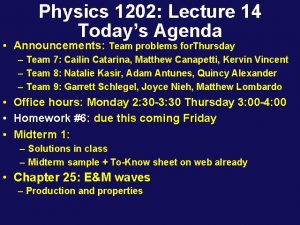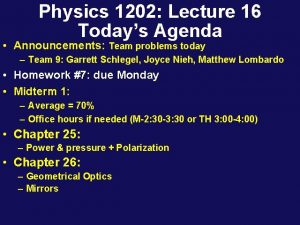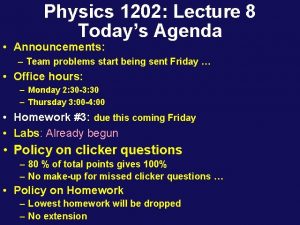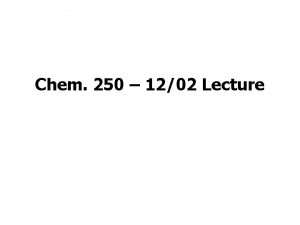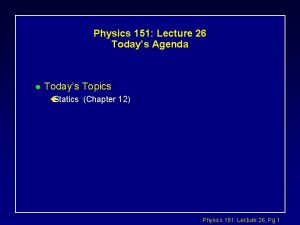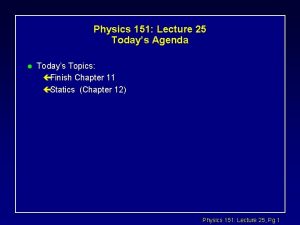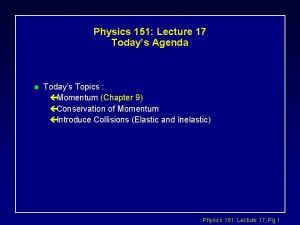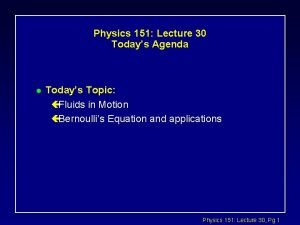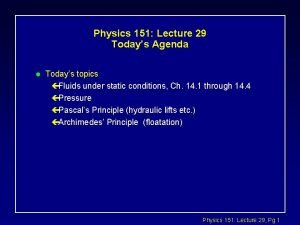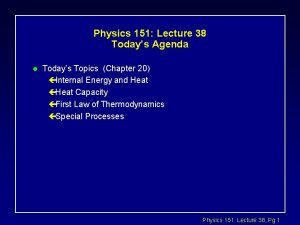Physics 1202 Lecture 4 Todays Agenda Announcements Lectures




















![Dimensions of capacitance • C = Q/V Þ [C] = F(arad) = C/V = Dimensions of capacitance • C = Q/V Þ [C] = F(arad) = C/V =](https://slidetodoc.com/presentation_image_h2/19f4f18b77a6f7b10b0aa2dd1e40d4ba/image-21.jpg)





























- Slides: 50

Physics 1202: Lecture 4 Today’s Agenda • Announcements: – Lectures posted on: www. phys. uconn. edu/~rcote/ – HW assignments, solutions etc. • Homework #1: – On Masterphysics: due this coming Friday – Go to the syllabus and click on instructions to register (in textbook section). – Make sure to input oyur information to google form https: //www. pearsonmylabandmastering. com/no rthamerica/ • Labs: Begin this week

Today’s Topic : • Chapter 20: Electric energy & potential – – Review of electric potential & Equipotentials Capacitors Effect of dielectrics Energy storage • Chapter 21: Electric current & DC-circuits – Electric current

20 -Electric Potential V Q 4 pe 0 r Q 4 pe 0 R R r R C R B r B q r A A path independence equipotentials

Electric potential V • By analogy with electric field • Therefore F ------------- Þ + • We have +++++++++++++ Þ

Point charges • For a point charge, the formula is: • For N charges �simply the algebraic sum of the potential due to each charge separately. Þ r 1 q 2 x r 2 r 3 q 3

20 -4: Equipotentials Defined as: The locus of points with the same potential. • Example: for a point charge, the equipotentials are spheres centered on the charge. • GENERAL PROPERTY: – The Electric Field is always perpendicular to an Equipotential Surface. • Why? ? Along the surface, there is NO change in V (it’s an equipotential!) So, there is NO E component along the surface either… E must therefore be normal to surface

Equipotential Surfaces: examples • For two point charges: © 2017 Pearson Education, Inc.

Conductors + + + + • • • Claim + + + The surface of a conductor is always an equipotential surface (in fact, the entire conductor is an equipotential) Why? ? If surface were not equipotential, there would be an Electric Field component parallel to the surface and the charges would move!! Note Positive charges move from regions of higher potential to lower potential (move from high potential energy to lower PE). Equilibrium means charges rearrange so potentials equal.

Charge on Conductors? • How is charge distributed on the surface of a conductor? – KEY: Must produce E=0 inside the conductor and E normal to the surface. Spherical example + + + - -- + +q - - + - E=0 inside conducting shell. + + + (with little off-center charge): charge density induced on inner surface non-uniform. charge density induced on outer surface uniform E outside has spherical symmetry centered on spherical conducting shell.

A Point Charge Near Conducting Plane q + V=0 a - - - -- - - - - -

A Point Charge Near Conducting Plane q + a The magnitude of the force is Image Charge The test charge is attracted to a conducting plane

Equipotential Example • Field lines more closely spaced near end with most curvature. • Field lines ^ to surface near the surface (since surface is equipotential). • Equipotentials have similar shape as surface near the surface. • Equipotentials will look more circular (spherical) at large r.

Equipotential & Electric Field • An ideal conductor is an equipotential surface • 2 conductors at same V, the more curved one has a larger electric field around it • Also true for different parts of the same conductor – Explains why more charges at edges

Applications: human body • There are electric fields inside the human body – the body is not a perfect conductor, so there also potential differences. • An electrocardiograph plots the heart’s electrical activity • An electroencephalograph measures the electrical activity of the brain:

20 -5 Definitions & Examples a b L A ++++ d -----

Capacitance • A capacitor is a device whose purpose is to store electrical energy which can then be released in a controlled manner during a short period of time. + - • A capacitor consists of 2 spatially separated conductors which can be charged to +Q and -Q respectively. • The capacitance is derived from the capacity to carry a charge Q when a voltage V is applied Q=CV DV or V • The capacitance is defined as the ratio of the charge on one conductor of the capacitor to the potential difference between the conductors. Q ++++ -----

Capacitance • A capacitance C of the device Q=CV DV or V Q ++++ ----- – Should not depend on Q nor V ! – That means should depend on how it is made – Material, geometry, dimensions • Should be intrinsic to the capacitor. • Is this a "good" definition? Does the capacitance belong only to the capacitor, independent of the charge and voltage ?

Example: Parallel Plate Capacitor • Calculate the capacitance. We assume +s, - s charge densities on each plate with potential difference V: • Need Q: • Need V: recall so or where Dx = d

Recall: Two infinite planes • Same charge but opposite • Fields of both planes cancel outside • They add up inside +++++++++++++ ------------- Perfect to store energy !

Example: Parallel Plate Capacitor • Calculate the capacitance: Assume +Q, -Q on plates with potential difference V. d A ++++ ----- Þ • As hoped for, the capacitance of this capacitor depends only on its geometry (A, d).
![Dimensions of capacitance C QV Þ C Farad CV Dimensions of capacitance • C = Q/V Þ [C] = F(arad) = C/V =](https://slidetodoc.com/presentation_image_h2/19f4f18b77a6f7b10b0aa2dd1e40d4ba/image-21.jpg)
Dimensions of capacitance • C = Q/V Þ [C] = F(arad) = C/V = [Q/V] • A Farad is very large – Often will see µF or p. F A ++++ d ----- • Example: Two plates, A = 10 cm x 10 cm d = 1 cm apart Þ C = Ae 0/d = = 0. 01 m 2/0. 01 m * 8. 852 e-12 C 2/Jm = 8. 852 X 10 -12 F = 8. 852 p. F

Lecture 4 – ACT 1 • Suppose the capacitor shown here is charged to Q and then the battery disconnected. • Now suppose I pull the plates further apart so that the final separation is d 1 > d A ++++ d ----- A ++++ d 1 ----- If the initial capacitance is C 0 and the final capacitance is C 1, is … A) C 1 > C 0 B) C 1 = C 0 C) C 1 < C 0

Example : Isolated Sphere • Can we define the capacitance of a single isolated sphere ? + + + • The sphere has the ability to store a certain amount of charge at a given voltage (versus V=0 at infinity) • Need DV: V = 0 VR = ke. Q/R • So, C = R/ke +

Dielectrics • Empirical observation: Inserting a non-conducting material between the plates of a capacitor changes the VALUE of the capacitance. • For the same charge Q 0 – Lowers the potential difference – Increases the capacitance

Dielectrics • A dielectric is an insulating material that, when placed between the plates of a capacitor, increases the capacitance • Why ? polarization of the material.

An Atomic Description of Dielectrics ∙ Polarization of the material �alignment of small dipoles create a small electric field Epol �Epol is in the opposite direction ∙ Ratio without/with dielectric ∙ The field is smaller: k > 1

Parallel Plate Example – Charge Q remains constant +++++++ - • Now insert material with dielectric constant k. ------- - But E and V are related by Voltage decreases from V 0 to – So…, C = k C 0 + Electric field decreases also: + • An amount of charge Q = C 0 V 0 is deposited on each plate. +++++++ + + - - • Charge a parallel plate capacitor filled with vacuum (air) to potential difference V 0. -------

Dielectrics • Definition: • The dielectric constant of a material is the ratio of the capacitance when filled with the dielectric to that without it. i. e. k values are always > 1 (e. g. , glass = 5. 6; – water = 78) – They INCREASE the capacitance of a capacitor (generally good, since it is hard to make “big” capacitors – They permit more energy to be stored on a given capacitor than otherwise with vacuum (i. e. , air)

20 -5 Capacitors and Dielectrics • If the electric field in a dielectric becomes too large • it can tear the electrons off the atoms, thereby enabling the material to conduct. This is called dielectric breakdown; the field at which this happens is called the dielectric strength. © 2017 Pearson Education, Inc.

Applications of Capacitors Camera Flash ∙ The flash attachment on a camera uses a capacitor �A battery is used to charge the capacitor �The energy stored in the capacitor is released when the button is pushed to take a picture �The charge is delivered very quickly, illuminating the subject when more light is needed

Applications of Capacitors Computers ∙ Computers use capacitors in many ways �Some keyboards use capacitors at the bases of the keys �When the key is pressed, the capacitor spacing decreases and the capacitance increases �The key is recognized by the change in capacitance

Energy of a Capacitor • How much energy is stored in a charged capacitor? – Calculate the work provided (usually by a battery) to charge a capacitor to +/- Q: Calculate incremental work DW needed to add charge Dq to capacitor at voltage V: - + • But DW is also the change in potential energy DU • The total U to charge to Q is shaded triangle: V Vq Vq=q/C Dq • In terms of the voltage V: q Q

Lecture 4 – ACT 2 The same capacitor as last time. The capacitor is charged to Q and then the battery disconnected. Then I pull the plates further apart so that the final separation is d 1 > d If the initial energy is U 0 and the final capacitance is U 1, is … A) U 1 > U 0 B) U 1 = U 0 C) U 1 < U 0 A ++++ d ----- A ++++ d 1 -----

Where is the Energy Stored? • Claim: energy is stored in the Electric field itself. Think of the energy needed to charge the capacitor as being the energy needed to create the field. • To calculate the energy density in the field, first consider the constant field generated by a parallel plate capacitor: • The Electric field is given by: Þ • The energy density u in the field is given by: Units: J/m 3

Summary • Suppose the capacitor shown here is charged to Q and then the battery disconnected. A ++++ d ----- • Now suppose I pull the plates further apart so that the final separation is d 1. • How do the quantities Q, W, C, V, E change? • • • Q: W: C: V: E: remains the same. . no way for charge to leave. increases. . add energy to system by separating decreases. . since energy , but Q remains same increases. . since C ¯, but Q remains same remains the same. . depends only on chg density • How much do these quantities change? . . exercise for student!! answers:

21 e R I =RI


Overview • Charges in motion – mechanical motion – electric current • How charges move in a conductor • Definition of electric current

Charges in Motion • Up to now we have considered – fixed charges on isolated bodies – motion under simple forces (e. g. a single charge moving in a constant electric field) • We have also considered conductors – charges are free to move – we also said that E=0 inside a conductor • If E=0 and there is any friction (resistance) present no charge will move!

Charges in motion • We know from experience that charges do move inside conductors - this is the definition of a conductor E Is there a contradiction? no V 1 E V 2 • Up to now we have considered isolated conductors in equilibrium. – Charge has nowhere to go except shift around on the body. – Charges shift until they cancel the E field, then come to rest. • Now we consider circuits in which charges can circulate if driven by a force such as a battery.

Analogy with fluids • Consider a hose filled with water – Need a difference of potential for fluid to flow – Same is true for electric charges

Current Definition + + + E + l l l + Consider charges moving down a conductor in which Note: Thisfield. definition assumes there is an electric the current in the direction of If we take a cross section of the wire, over some amount the count positive particles, of time Dt we will a certain number of charges (or total amount of charge) DQ moving by. We define current as the ratio quantities, NOT in the direction of of thethese electrons! l l + Iavg = DQ / Dt Units for I, Coulombs/Second (C/s) or Amperes (A)

How charges move in a conducting material E l l Electric force causes gradual drift of bouncing electrons down the wire in the direction of -E. Drift speed of the electrons is VERY slow compared to the speed of their bouncing motion, roughly 1 m / h ! (see example later) Good conductors are those with LOTS of mobile electrons.

How charges move in a conducting material E l DQ is the number of carriers in some volume times the charge on each carrier (q). l Let n be the carrier density, n = # carriers / volume. l The relevant volume is A * (vd Dt). Why ? l So, DQ = n A vd Dt q l And Iavg = DQ/Dt = n A vd q l More on this later … vd = Δx/ Δt

Drift speed in a copper wire • The copper wire in a typical residential building has a cross-section area of 3. 31 e-6 m 2. If it carries a current of 10. 0 A, what is the drift speed of the electrons? (Assume that each copper atom contributes one free electron to the current. ) The density of copper is 8. 95 g/cm 3, its molar mass 63. 5 g/mol. • Volume of copper (1 mol): • Because each copper atom contributes one free electron to the current, we have (n = #carriers/volume)

Drift speed in a copper wire, ctd. • We find that the drift speed is with charge / electron q • Thus

What makes charges move ? • Need to create DV E – recall W = -DU • A battery uses chemical reactions to produce a V 1 V 2 potential difference • Fluid analogy: person lifting water causing it to flow through the paddle wheel and do work.

Electromotive “force” - • Remember—despite its name, the emf is an electric potential, not a force. • The amount of work it takes to move a charge ΔQ from one terminal to the other is: + • Electric potential difference between the terminals of a battery is called the electromotive force or emf: e

Electric current • The direction of current flow—from the positive terminal to the negative one—was decided before it was realized that electrons are negatively charged. Therefore, current flows around a circuit in the direction a positive charge would move; electrons move the other way. However, this does not matter in most circuits. © 2017 Pearson Education, Inc.

Recap of today’s lecture • Chapter 20: Electric energy & potential – – Review of electric potential & Equipotentials Capacitors Effect of dielectrics Energy storage • Chapter 21: Electric current & DC-circuits – Electric current • Homework #1 on Mastering Physics – From Chapter 19 – Due this Friday – Labs started this week
 Joachim da fiore
Joachim da fiore Bluetooth antenna length
Bluetooth antenna length Finite wing
Finite wing Todays agenda
Todays agenda Frcr physics lectures
Frcr physics lectures Frcr physics lectures
Frcr physics lectures General announcements
General announcements David ritthaler
David ritthaler What two announcements did montag hear
What two announcements did montag hear Pvu official announcement
Pvu official announcement Kayl announcements
Kayl announcements R/announcements
R/announcements 01:640:244 lecture notes - lecture 15: plat, idah, farad
01:640:244 lecture notes - lecture 15: plat, idah, farad Agenda sistemica y agenda institucional
Agenda sistemica y agenda institucional Physics 101 lecture 1
Physics 101 lecture 1 Physics 101 lecture notes pdf
Physics 101 lecture notes pdf Waves pdf notes
Waves pdf notes What is a harmonic wave in physics
What is a harmonic wave in physics Physics 111 lecture notes
Physics 111 lecture notes Atmospheric physics lecture notes
Atmospheric physics lecture notes Digital logic design lectures
Digital logic design lectures Cs106b lectures
Cs106b lectures Pathology lectures for medical students
Pathology lectures for medical students Medicinal chemistry lectures
Medicinal chemistry lectures Reinforcement learning lectures
Reinforcement learning lectures Cs106b lectures
Cs106b lectures C programming lectures
C programming lectures Power system lectures
Power system lectures Utilities and energy lectures
Utilities and energy lectures Cern summer school lectures
Cern summer school lectures Molecular biology lectures
Molecular biology lectures Stratog online lectures
Stratog online lectures Comsats virtual campus lectures
Comsats virtual campus lectures Rick trebino lectures
Rick trebino lectures Theory of translation lectures
Theory of translation lectures Jim kurose gaia
Jim kurose gaia Blood physiology guyton
Blood physiology guyton Dr asim lectures
Dr asim lectures Orthopedic ppt lectures
Orthopedic ppt lectures Bba lectures
Bba lectures Haematology lectures
Haematology lectures Theory and practice of translation lectures
Theory and practice of translation lectures Introduction to web engineering
Introduction to web engineering Radio astronomy lectures
Radio astronomy lectures Bhadeshia lectures
Bhadeshia lectures Hugh blair lectures on rhetoric
Hugh blair lectures on rhetoric Neonatology lectures
Neonatology lectures Reinforcement learning lectures
Reinforcement learning lectures Cdeep lectures
Cdeep lectures What is hegelian philosophy
What is hegelian philosophy Aerodynamics lectures
Aerodynamics lectures
